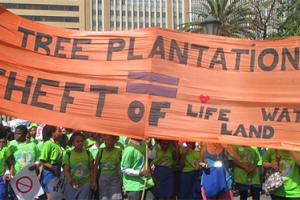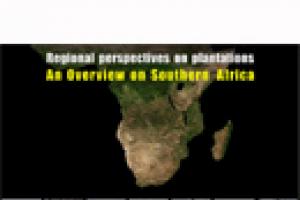Sign this letter to alert people in the global North! Stop development agencies from promoting expansion of large-scale tree plantations.
Malawi
Action alerts
10 September 2020
Bulletin articles
9 January 2018
In order to better understand peoples' struggles across the southern and eastern regions of Africa, reflecting on its history is crucial. This editorial highlights some parts of this history. And this, of course, is just the tip of the iceberg.
Other information
9 January 2018
This briefing, compiled by the World Rainforest Movement (WRM) and the Timberwatch Coalition (TW), is now also available in Swahili. It focuses on various internal and external factors determining changes in the extent of land under industrial tree plantations in 11 eastern and southern African countries: Malawi, Mozambique, Zambia and Zimbabwe; Kenya, Tanzania and Uganda; South Africa, Swaziland and Lesotho; and Madagascar.
Bulletin articles
9 January 2018
This article gives an overview on the industrial tree plantation expansion threat in eastern and southern African countries, its external drivers, as well as the challenges this expansion presents to affected communities struggling to defend their land and livelihoods.
Publications
5 October 2016
Download the publication. Also available in Swahili.
Other information
30 August 2012
Members of farmers’ organizations, women’s movements and civil society organizations from South Africa, Zimbabwe, Malawi, Swaziland, Lesotho, the DRC and Mozambique gathered on August 15-16 in Maputo, Mozambique, to analyze the multi-dimensional global crisis and the response of African governments.
Publications
15 December 2008
Timber plantations in southern Africa are concentrated in South Africa, Zimbabwe and Swaziland, but they are also expanding in Mozambique. There are smaller areas in Angola, Zambia, Malawi and Tanzania. In South Africa, the largest areas are in the provinces of Mpumalanga, KwaZulu-Natal and the Eastern Cape, covering 1.5 million hectares of land. Additionally, an estimated 1.6 million hectares have been invaded by plantation species such as acacias (wattle), eucalyptus (gum) and pines.
Bulletin articles
12 February 2004
The Center for International Forestry Research has implemented a program called Adaptive Collaborative Management of Forests (ACM) for more than five years. At its most extensive, we worked in 11 countries (Nepal, Indonesia, Philippines, Kyrgyzstan, Malawi, Cameroon, Zimbabwe, Ghana, Madagascar, Bolivia and Brazil); and activities continue in eight. One of the striking elements of this work has been our success at involving women (and other marginalized groups) in our work with communities.
Bulletin articles
20 January 2000
To the reductionist viewpoint of Western silviculture, forests are mainly -if not exclusively- a source of roundwood for industrial purposes. Nevertheless, forests are not only the home for thousands of indigenous people in different regions of the world, but also a rich source of different goods -wood included- and services. Medicinal plants are one of such valuable products which indigenous people use in traditional medical practices.
Bulletin articles
24 July 1999
Malawi, a country with a total land area of 118.484 sq.kms, is located in Southeast Africa. Its lowlands, which receive heavy rainfall, are covered by grasslands, temperate forests and rainforests, but the country has suffered deforestation at a annual rate of 1.3% (1981/90).







